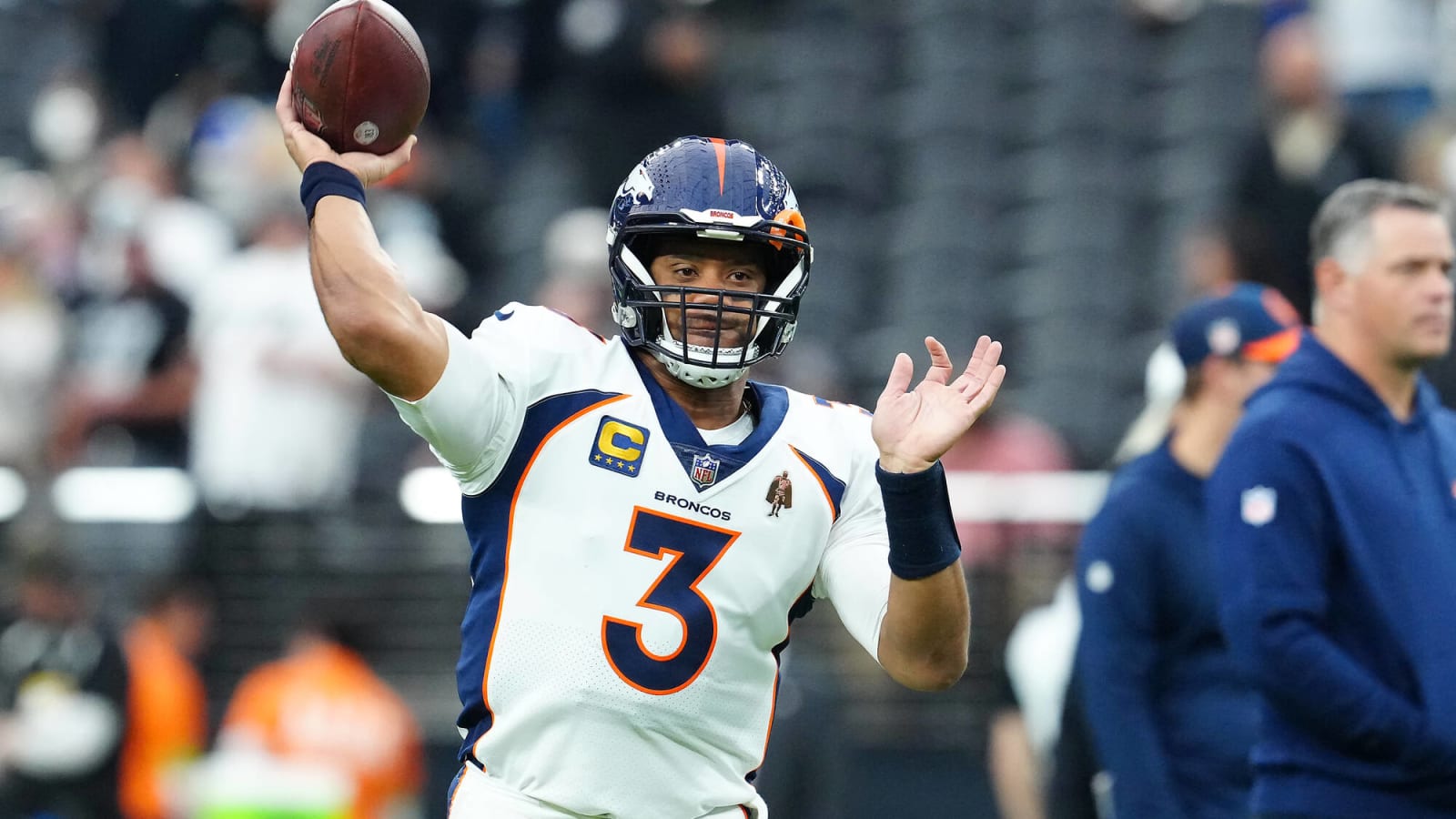
The Steelers' signing of Russell Wilson has caused a number of different reactions from the fan base. Some people love it. Some people hate it. Some don't think it makes sense in the long term, especially considering the impact it may have on Kenny Pickett's future.
On the field, how can Wilson fit in the Steelers' offense? How does his game mesh with Arthur Smith's system? Sure, there can be valid reason to be concerned over off-the-field issues. When one team is willing to eat $85 million in dead cap to go play somewhere else, it raises a lot of questions.
However, there are some fans who believe Wilson just doesn't have it anymore, that he's "washed" or can't play anymore. So, for a quarterback who now stands a chance to be the starter in Week 1, let's take a deep dive into the film and data and see what we come up with, and how it may or may not fit in Smith's system.
First, let's take a look at the positives. One thing that really jumps off the screen is Wilson's arm. Though it's not quite what it was in his prime, he's still got a great arm. Specifically, Wilson is still very, very good at throwing the deep ball:
— DK Pittsburgh Sports (@DKPSmedia) March 12, 2024
There's not much to describe here. This is just a beautiful ball from Wilson. He lets this go at his own 14-yard line on the left hash and Marvin Mims Jr. catches this in stride at the opponents' 40-yard line on the left sideline. That is still exceptional arm strength, but also with a great deal of touch. That's been something that Wilson's done well throughout his career, and he hasn't lost that.
As for sheer arm strength, yeah, Wilson can still fire lasers:
— DK Pittsburgh Sports (@DKPSmedia) March 12, 2024
This is a dot to Courtland Sutton. Wilson really steps into this for an absolute strike while looking off one linebacker and firing over another. And, it's to the middle of the field (more on that later).
The numbers back up Wilson's ability to be most dangerous when throwing deep. Last season, Wilson posted a 112.5 passer rating when throwing 20-plus yards down the field, which included six touchdown passes to only one interception. 20 of his 23 completions downfield were considered big time throws by Pro Football Focus. Wilson also ranked 11th among qualifying passers in big time throw percentage and also had the 11th-best percentage in turnover worthy plays when throwing deep. Not quite as elite as he used to be, but still an efficient and productive deep-ball passer.
Wilson's ability to throw the ball deep fits very well in Smith's offense, especially in play-action. Fortunately, Wilson's numbers there are exceptional, too. When passing off play-action, Wilson posted 117.2 passer rating, completing 67.6% of his passes for 10 touchdowns and only one interception, while averaging 7.45 yards per attempt. His average depth of target on play-action was 9.3 yards, which is exactly two yards more than when Wilson was throwing without play-action.
Smith's offense wants to run the ball first and foremost, and then test defenses vertically with play-action. Wilson can absolutely do that. It's one area of his game that fits very well.
Wilson prefers to play outside the pocket, and once upon a time, he was one of the best quarterbacks in the league at doing so. That's one of the things that will help him with consideration for the Hall of Fame. Simply put, Wilson doesn't have the prototypical quarterback build. He stands only 5-foot-11, which makes it very hard to break down defenses from the pocket. So, one thing he did to make up for that was use his superb arm and athleticism to his advantage. He'd get outside the pocket and have the ability to make both on- and off-platform throws. And, at times, he can still do those things:
— DK Pittsburgh Sports (@DKPSmedia) March 13, 2024
Again, can't ask for a better throw here, and he does it while on the run. This is where Wilson's background as a baseball player really helps (remember, he was selected in the fourth round of the 2010 MLB Draft). He has a natural ability to make strong, accurate throws on the run. That has always helped in his ability to be a playmaker outside the pocket.
And, it's encouraging to see that Wilson's athleticism seemed to improve last season after a disappointing 2022 campaign. Since Wilson's style of quarterback play hasn't really evolved over time, it requires a certain level of athleticism. So, that'll be something to watch for when the team reports to Saint Vincent College in July. What kind of shape is he in? How's he moving around? Is he making these type of throws on the run? These will be questions that need answers early on. If the answers are encouraging, so will the potential of Wilson being a productive quarterback in Pittsburgh.
However, this is kind of where we can move on to the negatives in Wilson's game nowadays. If Wilson were built differently, maybe he would have changed his game as he got older like we saw with Ben Roethlisberger. Ben went from a gun slinger playing backyard football to a calculated pocket passer as he aged. And, Ben actually put up better numbers when he transitioned to more of a pocket passer.
The good thing for Wilson is he's maintained efficiency playing the way he does. Last season, he completed 66.4% of his passes for 3,070 yards, 26 touchdowns and eight interceptions. The problem is this style comes with an expiration date, and Father Time tends to prevail a little quicker with quarterbacks that play like Wilson.
Another problem with quarterbacks that prefer to play out of structure is missed plays that could be easy gains through the air. A lot like Pickett, Wilson can try to abandon pockets far too early, missing open receivers if he had stayed in the pocket and let the play develop:
— DK Pittsburgh Sports (@DKPSmedia) March 13, 2024
Here, Wilson not only gets happy feet, but actually turns his back to the play trying to make the play a home run. In doing so, he misses the No. 3 receiver that runs open on the crosser to the right side of the field. This is just one example, but plays like these can happen multiple times per game.
Wilson wants to make every play a home run, which obviously comes with its drawbacks. Not only is it impossible to make every single play, it can put the offense behind the chains far too often. It also puts pressure on the offensive line. Wilson's average time to throw last season was 3.06 seconds, the third-highest time among qualifying passers. That will come with some reward, but also considerable risk.
And, of course, probably the most criticized portion of Wilson's game is the lack of throwing over the middle of the field. And, yeah, you don't have to do much digging to see how much he loves throwing outside the numbers as opposed to throwing over the middle of the field:
Even last season, Wilson only had 78 passing attempts over the middle. For context, only five quarterbacks that made at least 10 starts had fewer attempts to the middle of the field. The problem is Smith's offense does utilize the middle of the field quite often. Look at these heat maps from Ryan Tannehill when he played under Smith in 2020:
This is what happens when quarterbacks prefer to play out of structure. Too often they try to play hero ball and not let plays develop from the pocket. That can cause inefficiencies on offense, especially if and when the running game isn't going.
Here's something interesting, though. When Wilson does throw the ball over the middle, the numbers aren't all that bad. When he threw anywhere between 1-20 yards over the middle last season, Wilson completed 90 of 114 passes (78.9%) for 990 yards, an average of 8.7 yards per attempt. The drawback is Wilson threw only three touchdowns and four of his eight interceptions were thrown in this area of the field. However, all of that still equals a passer rating of 97.0. Based on the quarterback play the Steelers have gotten over the past two season, passer ratings in the 90s should be a warm welcome.
But, Wilson's limitations in the middle of the field do leave questions for how he can fit into Smith's offense. Wilson can test defenses vertically on play-action, but Smith's desire to call concepts designed for the middle of the field could be executed inconsistently.
FINAL THOUGHTS
When watching the film and looking at Wilson's style of play, it honestly reminded me a lot of Pickett, only Wilson is much, much more accomplished. Wilson's at his best when playing out of structure, but avoids the middle of the field too often and runs himself into pressure too often. That sounds an awful lot like Pickett.
So, if they are similar quarterbacks, why not just stick with the guy that was drafted in the first round instead of the guy on a one-year deal who'll turn 36 in November? Purely from an Xs and Os standpoint, there are two reasons. First, Wilson's got a much better arm. He still throws a great deep ball, and when he does throw to the middle of the field, his numbers are better than Pickett's, who posted an 81.25 passer rating over the middle last season. Second, Wilson is a better playmaker, even at this stage of his career:
— DK Pittsburgh Sports (@DKPSmedia) March 13, 2024
The Steelers have really missed having a playmaker at quarterback. Even in the early stages of Roethlisberger's career, the team was willing to put up with the bad plays because they knew his ability to play the way he did would also produce extraordinary results, as well. Wilson's not Roethlisberger, but if he can help provide anything extraordinary at the position, it's an improvement. And, I haven't once touched on what Wilson can add on the ground. Even last season at age 35, he tallied 341 yards and and three touchdowns on 80 carries. He can still make plays occasionally with his legs, too.
Of course, the flip side to this is Pickett's future as a Steeler is likely over if Wilson is named the starter. And, despite concerns over his performance in his first two seasons, there's always a chance that Pickett takes a big leap forward in his third season. He wouldn't be the first quarterback to go down that path.
But, deciding between Pickett and Wilson isn't the purpose of this Chalk Talk. That's ultimately a decision Mike Tomlin will have to make. This was meant to take a closer look into how Wilson fits into this offense, and what he could bring to Pittsburgh. From everything I've seen, even the 2023 version of Wilson is an upgrade over what the Steelers have had at quarterback.
Is Wilson a perfect fit? No, the lack of usage over the middle of the field really has me concerned about how he can consistently execute all portions of the playbook. But, there is enough of his game that fits into what the Steelers want to do on offense, specifically on play-action.
For the veteran minimum, just $1.21 million, adding Wilson is almost a no-brainer. With the Steelers' defense being upgraded by the acquisitions of Patrick Queen and Donte Jackson, Wilson's fit in Pittsburgh makes much more sense than it did in Denver. Wilson doesn't have to be the centerpiece in Pittsburgh. As long as his play can complement the running game while the defense does its thing, this can be a better football team in 2024.
More must-reads:
- Five retired NFL players we want back in 2025
- Steelers reward GM Omar Khan after busy offseason
- The 'NFL head coaches' quiz
Breaking News
Trending News
Customize Your Newsletter
 +
+
Get the latest news and rumors, customized to your favorite sports and teams. Emailed daily. Always free!








